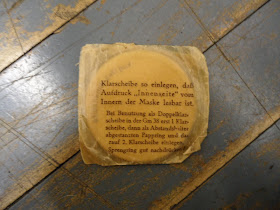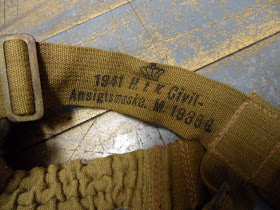GASMASKENBÜCHSE (Gas mask canister-can)
The gas mask canister is a long model, German military issue canister that is dated as 1943. The canister is missing the carry straps, but still has three packs of replacement lenses in their original wrappers in the lid case. The cleaning cloth retaining spring-clip is in the bottom of the canister, but the cloth is missing. The canister is over-painted in a "Normandy" style camouflage paint scheme. The case is exactly as I acquired it.

 Inside the lid of the canister is a holding case for the extra replacement lenses. Inside this holding case is a Waffenamt Stamp (Military Inspector Stamp) that has been punched into the metal. On the outside of the case lid there is a the maker's stamp of "ebu" in a triangle with the date code fo "43" indicating a 1943 manufacture date.
Inside the lid of the canister is a holding case for the extra replacement lenses. Inside this holding case is a Waffenamt Stamp (Military Inspector Stamp) that has been punched into the metal. On the outside of the case lid there is a the maker's stamp of "ebu" in a triangle with the date code fo "43" indicating a 1943 manufacture date.

 On the bottom of the canister is a letter "D" molded into the metal as well as the hand painted name of the original owner :Leib". If you look close at the painted name, you can see that it was originally painted on with a lighter colored paint and then later over-painted with a thicker black paint. The "D" indicates that the canister is leak proof.
On the bottom of the canister is a letter "D" molded into the metal as well as the hand painted name of the original owner :Leib". If you look close at the painted name, you can see that it was originally painted on with a lighter colored paint and then later over-painted with a thicker black paint. The "D" indicates that the canister is leak proof. The extra lenses are still in their original wrappers and have the date of 1943. There are three packages of lenses. The instructions on the wrappers indicate that the lenses are for the GM 38 gas mask, the standard German military gas mask of WW2.
The extra lenses are still in their original wrappers and have the date of 1943. There are three packages of lenses. The instructions on the wrappers indicate that the lenses are for the GM 38 gas mask, the standard German military gas mask of WW2.


 Unfortunately the straps for the case are missing, with the exception of one short end that was still attached to the case when I bought it. The rest of this remaining strap end had been cut away. With a magnifying glass, I can make out the faint makers stamp and date of 1942 on the canvas attaching tab.
Unfortunately the straps for the case are missing, with the exception of one short end that was still attached to the case when I bought it. The rest of this remaining strap end had been cut away. With a magnifying glass, I can make out the faint makers stamp and date of 1942 on the canvas attaching tab.

DANISH M38 CIVILIAN GAS MASK
Inside the german canister is a Danish Model 38 (M#*) Civilian gas Mask. The gas mask is date marked on the cloth straps with the date of 1941. The filter is date stamped with the date of July 1942. The canister and mask are both labeled as civilian models.



 For a more complete and in-depth article about these danish gas masks, take a jump over to the blog M55q at this link:
For a more complete and in-depth article about these danish gas masks, take a jump over to the blog M55q at this link:http://m55q.blogspot.com/2009/10/danish-m38-gas-mask-civilian-version.html
There are several very good articles covering Danish gas masks with tons of detailed information, so be sure to check out all of the pages!























